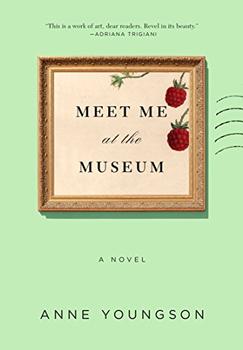Summary | Excerpt | Reviews | Beyond the Book | Read-Alikes | Genres & Themes | Author Bio

This article relates to Meet Me at the Museum
 Anne Youngson's debut work, Meet Me at the Museum is an epistolary novel consisting of letters between a farm wife living in England and a Danish museum curator. The correspondence begins when she writes to inquire about Tollund Man.
Anne Youngson's debut work, Meet Me at the Museum is an epistolary novel consisting of letters between a farm wife living in England and a Danish museum curator. The correspondence begins when she writes to inquire about Tollund Man.
The naturally mummified corpse known as Tollund Man (so named because he was found close to the small village of Tollund in Denmark) was discovered in 1950 by workers cutting peat for fuel. The body looked so lifelike they thought the remains were of a recent murder victim, and after some discussion, they summoned the local police. Puzzled, the authorities brought in P.V. Glob, an archaeologist from nearby Sikleborg, who determined the body was at least 2,000 years old. Glob went on to study other similarly preserved bodies, publishing his classic work The Bog People: Iron-Age Man Preserved in 1965. (This publication is mentioned in Youngson's preface.)
Although Tollund Man is arguably the most famous of these cadavers, he's by no means the only bog person; several hundred well-preserved bodies and skeletons have been unearthed in Northern Europe over the past few centuries, primarily in Denmark, Germany, England, Ireland and the Netherlands. Most date from the Iron Age, between 500 BCE and 100 CE, but some are even older; the body known as Cashel Man, discovered near Cashel, Ireland, is believed to be from circa 2,000 BCE (which would make him 700 years older than the Egyptian pharaoh, Tutankhamun).
The peat bogs of these regions are ideal for the preservation of bodies because most are located in raised basins with poor drainage, leaving the ground waterlogged. Layers of sphagnum moss accumulate on top of the water, limiting the mineral and oxygen levels and increasing acidity. Low regional temperatures add to the bogs' powers of preservation. Soon after burial, the acid starts tanning the skin, hair, and nails of the deceased. The sphagnum moss releases a polymer as it decomposes, binding to the nitrogen released by the cadaver and limiting bacterial growth. This further mummifies the corpse, but it also leaches out calcium (which is why many of the bog bodies look somewhat like a deflated toy).
The discovery of these bog bodies dates back to at least the 17th century. In 1780 an Irish peat cutter found a skeleton in a bog on land belonging to the Earl of Moira. The earl's wife, Elizabeth Rawdon, became fascinated by it and launched what's believed to be the first serious investigation of a bog body. She published her research results in the journal Archaeologia.
P.V Glob concluded that most of the bog bodies were victims of religious rites, believing Tollund Man and most of the others found were sacrificed to Nerthus, the Earth Mother, to ensure a good crop. Modern investigations find this conclusion somewhat simplistic. It was originally thought that many of the victims endured torture and gruesome deaths, but now scientists believe that what appeared to be injuries, such as broken bones and skull trauma, were more likely the result of the accumulated weight of the peat over centuries pressing down on the bodies. Still, the mystery of these individuals' deaths lingers. There's no doubt, for example, that Tollund Man died from hanging (evident by the rope-burn mark on the neck and the body's distended tongue), but we'll likely never know why he was killed.
Modern science continues to shed more light on the bog bodies. Most recently, techniques have been developed to analyze the levels of strontium (a mineral found in the earth and naturally absorbed by the body) in each corpse, which vary significantly from region to region, allowing researchers to pinpoint where individuals had been in the years before their deaths. It appears that some of the best preserved bog people were not from the regions in which they died, adding to speculation that their "otherness" contributed to their deaths. There are no written records from northern Europe during this time period, however, so a conclusive explanation remains unlikely.
Tollund Man on display at Silkeborg Museum
by Kim Kovacs
Filed under Cultural Curiosities
![]() This "beyond the book article" relates to Meet Me at the Museum. It originally ran in August 2018 and has been updated for the
August 2019 paperback edition.
Go to magazine.
This "beyond the book article" relates to Meet Me at the Museum. It originally ran in August 2018 and has been updated for the
August 2019 paperback edition.
Go to magazine.
Courage - a perfect sensibility of the measure of danger, and a mental willingness to endure it.
Click Here to find out who said this, as well as discovering other famous literary quotes!
Your guide toexceptional books
BookBrowse seeks out and recommends the best in contemporary fiction and nonfiction—books that not only engage and entertain but also deepen our understanding of ourselves and the world around us.